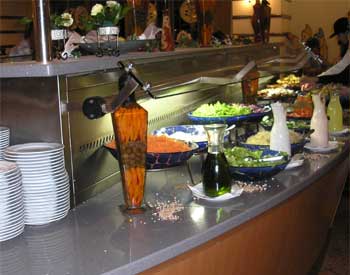 |
Salad bars are becoming popular again. During the ’70s and ’80s, you couldn’t walk into a restaurant without running into one, mostly because they were often as big as a Winnebago. In theory, salad bars are a great thought–all that yummy stuff packed into one spot, ripe for the taking–but there is a lot that can go wrong with this super-bounty of food. One thing is for certain: you are at the mercy of the restaurant to make sure that the salad bar is safe territory, not some dangerous food-cart of death. Here are some minor annoyances, and some information that might just scare the crap out of you.
1) No Sneeze Guard, No Go
First and foremost, appearance is your main indicator to whether or not the salad bar is a viable option. Look for a sneeze guard, preferably a secure and clean one (not dripping with two day-old ranch dressing) that is about 15 inches between you and the food. If the salad bar doesn’t have a sneeze guard, you may want to pass on the cornucopia of offerings, unless you like missing hairs and possible boogers in you food.
2) That’s One Filthy Salad Bar
It doesn’t take long for a heavily trafficked salad bar to become trashed. And it’s the responsibility of the restaurant to keep it stocked and cleaned, which some places take seriously, and others don’t. Some people feel that a heavy dousing of bleach is the way to properly clean a salad bar. But one must be careful to get the soap/bleach/hot water ratio just right, or all the diner will smell (and taste!) is bleach. Even worse than too much bleach is no bleach at all, meaning the salad bar occasionally gets wiped down with a filthy towel, swimming with food borne microorganisms.
3) Restock, Rotate, Recycle
Restocking and rotating the food is paramount for the success of a salad bar. But it can also be a scary prospect if the kitchen crew is not diligent about keeping the food as fresh as possible. Those fancy crocks and etched bowls, which ornately hold the food, can become a stratum of bacterial layers–new pasta salad, let’s say, on top of the old stuff, for days, until the bowl finally gets emptied. As a general rule of thumb, cooks are not supposed to mix old and new food, but some of them are lazy and apathetic. It’s risky business.
4) The Ice Man Didn’t Cometh
A properly iced salad bar is of utmost importance. Cold food simply needs to remain cold. And when salad bars start to warm up–watch out! Potato salad (and other mayonnaise-based items) can become potentially dangerous to diners. Restaurants are supposed to keep cold food at 40 degrees or below and hot food at 140 degrees and above, yet don’t just assume that the food in a salad bar is being held at safe temperatures. If you are really worried, consider bringing your own pocket thermometer, to probe the food, but that would make you seem like an obsessive freak. Take a deep breath… and keep telling yourself that it’s probably safe.
5) All Those Dirty Hands
You can make yourself sick just thinking about all the people that actually touch the utensils at a salad bar over the course of one day. The very thought of some dude scratching his ass right before grabbing the salad tongs is a real turn off. Restaurants should clean (and not with that filthy towel!) and replace utensils throughout the course of service. But when it gets busy, the salad bar is usually the first thing that gets neglected. Plus, spoons, ladles, and tongs often fall into the salad bowls and salad dressing containers, making for a sticky situation.
We always want to be transparent and honest about our article content. From time to time, we may link to products and services that compensate us for the referral. This does not affect your cost, but it does help us fund future content for this site.
